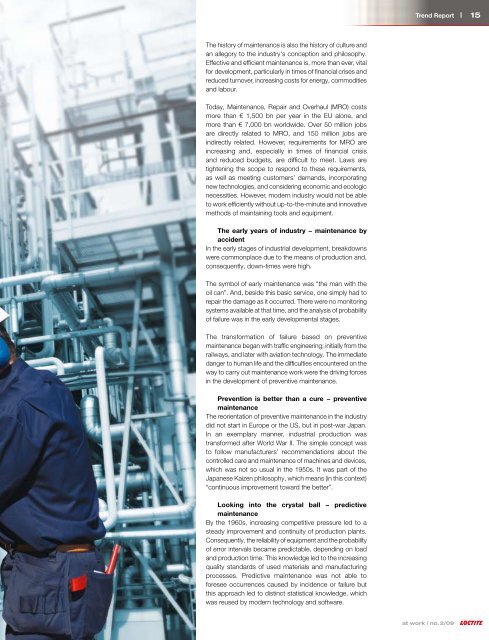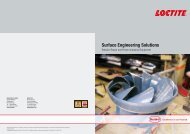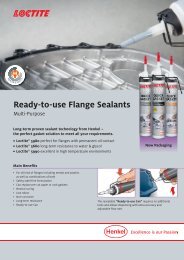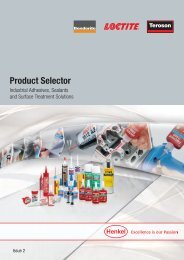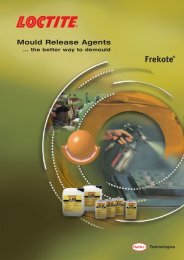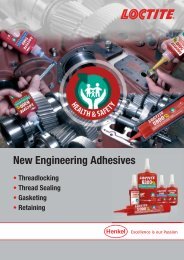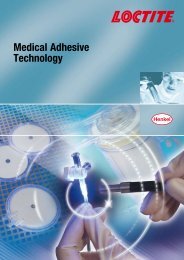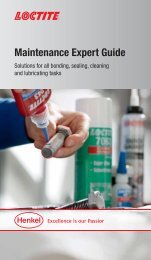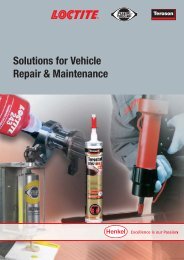How to set up a Porsche GT3 for the âPorsche Mobil 1 ... - Loctite
How to set up a Porsche GT3 for the âPorsche Mobil 1 ... - Loctite
How to set up a Porsche GT3 for the âPorsche Mobil 1 ... - Loctite
- No tags were found...
Create successful ePaper yourself
Turn your PDF publications into a flip-book with our unique Google optimized e-Paper software.
Trend Report| 15The his<strong>to</strong>ry of maintenance is also <strong>the</strong> his<strong>to</strong>ry of culture andan allegory <strong>to</strong> <strong>the</strong> industry's conception and philosophy.Effective and efficient maintenance is, more than ever, vital<strong>for</strong> development, particularly in times of financial crises andreduced turnover, increasing costs <strong>for</strong> energy, commoditiesand labour.Today, Maintenance, Repair and Overhaul (MRO) costsmore than € 1,500 bn per year in <strong>the</strong> EU alone, andmore than € 7,000 bn worldwide. Over 50 million jobsare directly related <strong>to</strong> MRO, and 150 million jobs areindirectly related. <strong>How</strong>ever, requirements <strong>for</strong> MRO areincreasing and, especially in times of financial crisisand reduced budgets, are difficult <strong>to</strong> meet. Laws aretightening <strong>the</strong> scope <strong>to</strong> respond <strong>to</strong> <strong>the</strong>se requirements,as well as meeting cus<strong>to</strong>mers’ demands, incorporatingnew technologies, and considering economic and ecologicnecessities. <strong>How</strong>ever, modern industry would not be able<strong>to</strong> work efficiently without <strong>up</strong>-<strong>to</strong>-<strong>the</strong>-minute and innovativemethods of maintaining <strong>to</strong>ols and equipment.The early years of industry − maintenance byaccidentIn <strong>the</strong> early stages of industrial development, breakdownswere commonplace due <strong>to</strong> <strong>the</strong> means of production and,consequently, down-times were high.The symbol of early maintenance was “<strong>the</strong> man with <strong>the</strong>oil can”. And, beside this basic service, one simply had <strong>to</strong>repair <strong>the</strong> damage as it occurred. There were no moni<strong>to</strong>ringsystems available at that time, and <strong>the</strong> analysis of probabilityof failure was in <strong>the</strong> early developmental stages.The trans<strong>for</strong>mation of failure based on preventivemaintenance began with traffic engineering; initially from <strong>the</strong>railways, and later with aviation technology. The immediatedanger <strong>to</strong> human life and <strong>the</strong> difficulties encountered on <strong>the</strong>way <strong>to</strong> carry out maintenance work were <strong>the</strong> driving <strong>for</strong>cesin <strong>the</strong> development of preventive maintenance.Prevention is better than a cure − preventivemaintenanceThe reorientation of preventive maintenance in <strong>the</strong> industrydid not start in Europe or <strong>the</strong> US, but in post-war Japan.In an exemplary manner, industrial production wastrans<strong>for</strong>med after World War II. The simple concept was<strong>to</strong> follow manufacturers’ recommendations about <strong>the</strong>controlled care and maintenance of machines and devices,which was not so usual in <strong>the</strong> 1950s. It was part of <strong>the</strong>Japanese Kaizen philosophy, which means (in this context)“continuous improvement <strong>to</strong>ward <strong>the</strong> better”.Looking in<strong>to</strong> <strong>the</strong> crystal ball − predictivemaintenanceBy <strong>the</strong> 1960s, increasing competitive pressure led <strong>to</strong> asteady improvement and continuity of production plants.Consequently, <strong>the</strong> reliability of equipment and <strong>the</strong> probabilityof error intervals became predictable, depending on loadand production time. This knowledge led <strong>to</strong> <strong>the</strong> increasingquality standards of used materials and manufacturingprocesses. Predictive maintenance was not able <strong>to</strong><strong>for</strong>esee occurrences caused by incidence or failure butthis approach led <strong>to</strong> distinct statistical knowledge, whichwas reused by modern technology and software.at work | no. 2/09


